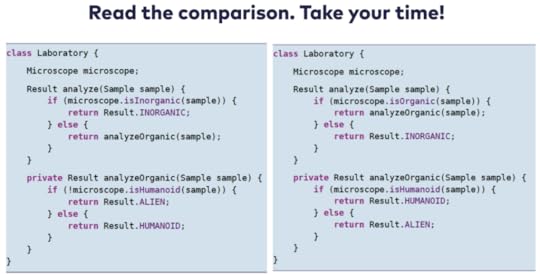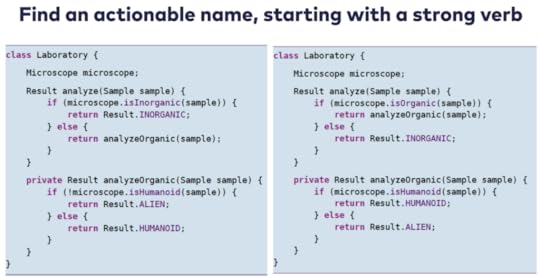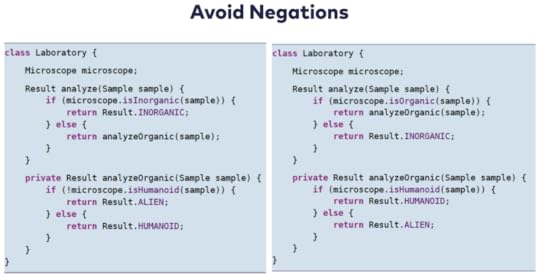Comparison Jeopardy
 Photo by chuttersnap on Comparison with bad code on the left and better code on the right.
Photo by chuttersnap on Comparison with bad code on the left and better code on the right.At first, you show a comparison. Here’s an example of a comparison with bad code on the left and better code on the right, taken from our book Java by Comparison. Be sure to align the code listings so that any participant can compare it easily. Also, check that you use code snippets that aren’t too large and still readable when projected on the wall. We put a lot of effort into making the code snippets in our book concise, leaving out things like visibility modifiers like “public” if they didn’t add value. We advise you to do that, too.

We gave the audience some time to read the code, typically a minute or two, so they could ponder on the comparison. During that time, you shouldn’t say anything and really let the audience read and think. We recommend setting a timer to make sure you give the audience enough time. You may take your time now reading the code above, so you can experience the game as well!
 Tell the audience to find an actionable name for that comparison that starts with a strong verb.
Tell the audience to find an actionable name for that comparison that starts with a strong verb.After a few minutes of silence, we asked them how they would name that comparison. The only restriction we put out is that the name must start with a verb, preferably strong verbs. Tell them to try to stay away from weak verbs like “avoid”, “use” or “do”. We discussed each name whether it would really convey the meaning of this comparison with the audience. Make sure to take your time here, because this is the most interesting part. And be prepared that they come up with way better names than you had in mind for the comparison, which is a good thing!
 Comparison including the suggested name
Comparison including the suggested nameLast, show them the name you’ve chosen as shown in the example below. From our experience, normally, our name was simply acknowledged as very good. Sometimes, however, it fuelled yet another short but interesting discussion.
Don’t forget to write down the suggestions of the audience, especially the ones that were better than your own name. For that, it’s best to moderate the game with two “game show hosts”, so that one can participate in the discussion and the other can just follow the discussion, taking notes when necessary. We typically take turns, so that it’s fun for both hosts.
Tried and TestedLinus and I have tried out the game three times already, each time in a different setting using up to ten comparisons from our book:
At university with studentsAt a meetup with students and professionalsAt an internal company meeting with professionalsAnd each time, we got very positive feedback. We hope to play that game at some other meetups and companies in the future as well. We’ll update that site here if we learn more about how to play “Comparison Jeopardy” even better. Stay tuned!




